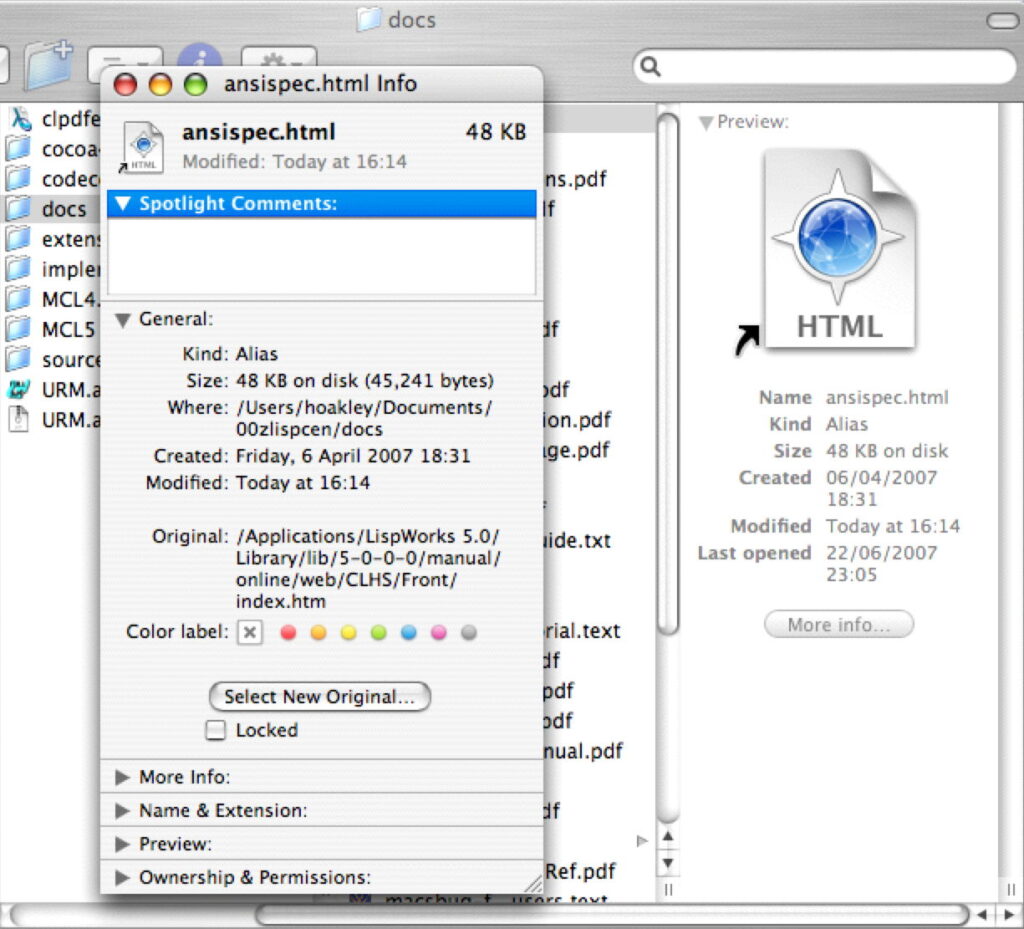A brief history of the Finder Alias

It wasn’t until System 7 in 1991 that the Mac gained any feature that let the user create links to files or folders. Without a command shell, Unix traditions of symbolic and hard links weren’t available. Apple belatedly added what it termed an alias, created using the Make Alias command in the Finder’s File menu. This made a document-like object bearing the name of its original with alias appended, displayed in italics to distinguish it from the original. To help users locate the original file for an alias, the Finder’s Get Info dialog gained a button to Find Original, later moved to the File and contextual menus.
Later versions of classic Mac OS added refinements to this transformative feature, including the selection of a new target for a broken alias, creation by drag-and-drop of a file or folder with the Command and Option keys held, and a distinctive arrow badge to both the item’s icon and the pointer during drag-creation.
Internally, the alias was a small file of less than 5 KB size containing opaque data with more information than just the path to the original. Aliases were designed to support free movement within the same file system, at the time an HFS volume (or partition, as they’re the same in HFS and HFS+).
Aliases transferred across to Mac OS X, where the more adventurous could open Terminal and create both symbolic and hard links instead. It has remained a sign of the lasting schism between the GUI and Unix internals of Mac OS X that there are no standard command tools supporting Finder aliases, and there’s no way to create or maintain symbolic or hard links in the Finder.
Something happened to aliases when they transitioned into Mac OS X, and their size started to rise steadily until they reached 1-5 MB in El Capitan.
Back in Mac OS X 10.4 Tiger they were still fairly small, this one at 48 KB. Note the Select New Original… button in the Get Info dialog.
Aliases were all very good for the user, but OS X needed something similar that could be stored in property lists and other files, so the alias format was rejigged into more generalised form as the bookmark, introduced in OS X 10.6 in 2009. In early 2012 with 10.7.3, bookmarks could be security-scoped with permission on a per-app or per-document basis, to enable their use with the app sandbox. By OS X 10.9 Mavericks in 2013, bookmarks were in widespread use throughout the system.
In El Capitan (2015), bookmark size often reached 1 MB, while the Select New Original… button remained the same in the Get Info dialog.
macOS Sierra brought a major revision to both aliases and bookmarks, reducing their size substantially, but bringing other problems. As late as 10.12.1 they were still having problems resolving some links. The end result was worth the struggle, though, as they have since become more robust than ever, with a typical size of only 1 KB, making them almost as efficient as symbolic links.
Although aliases and bookmarks are still intended to be treated as opaque, their contents have become more accessible. Among the useful values each contains are:
_NSURLPathKey gives the full path to the file,
_NSURLFileIDKey gives the inode number of the file,
_NSURLBookmarkURLStringKey gives the file’s full URL,
NSURLCreationDateKey gives the file’s creation timestamp,
NSURLIsRegularFileKey indicates whether it’s a normal file,
NSURLIsPackageKey indicates whether it’s a package rather than a file,
_NSURLBookmarkSecurityScopeCryptoKeyKey is used if this is a Security-Scoped Bookmark, most used with sandboxed apps.
I even have a couple of utilities that work with them. Among the many features of Precize is the ability to generate bookmarks, and to analyse and resolve them. For those who want to bridge the divide between the GUI and command line, alisma is a tool that can both create aliases and resolve them to paths. Finally, Alifix helps you refresh and identify broken aliases.


